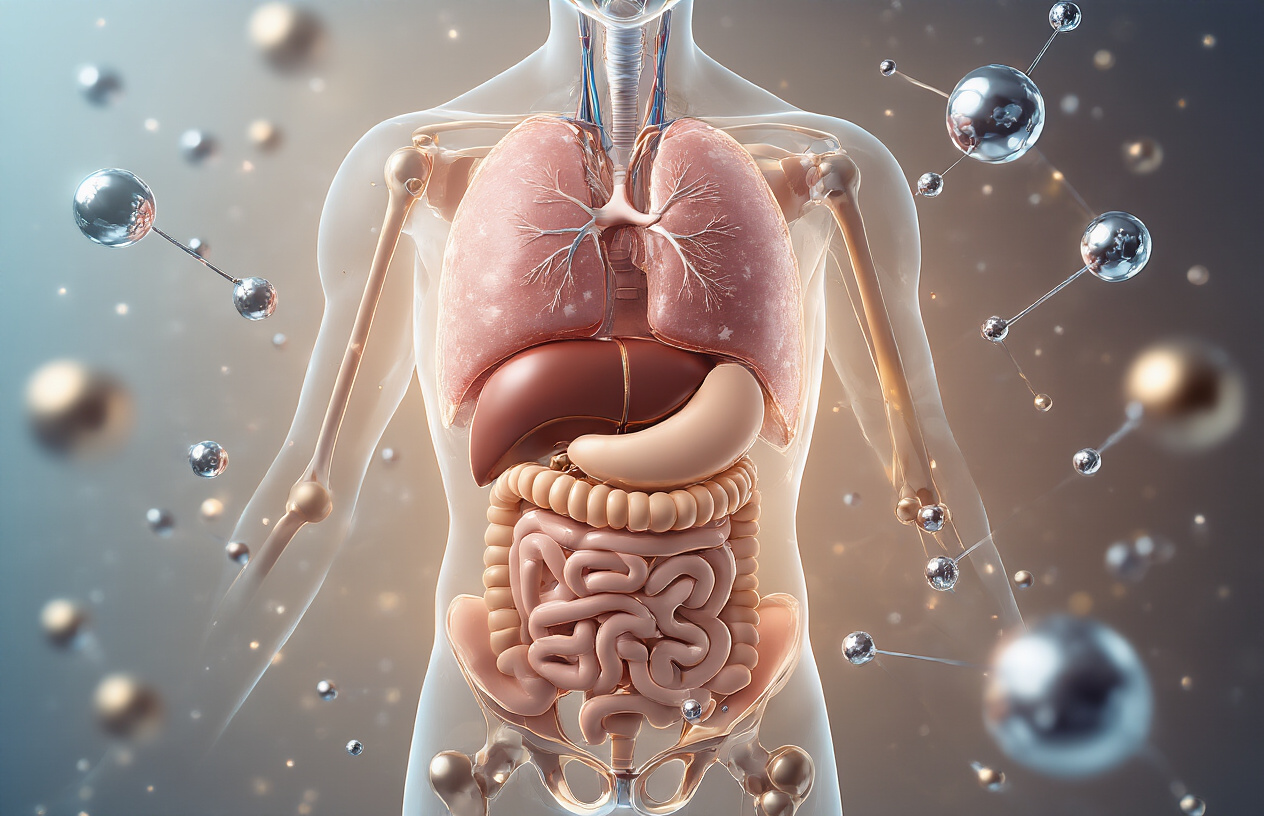Chromium often gets overlooked in conversations about essential nutrients, but this trace mineral plays a crucial role in keeping your body running smoothly. This guide is for health-conscious individuals, fitness enthusiasts, and anyone managing blood sugar concerns who wants to understand how chromium affects their wellbeing.
You’ll discover how chromium supports blood sugar control and boosts your metabolism, helping your body process carbs more efficiently. We’ll also explore the best food sources to get this vital mineral naturally and help you recognize the warning signs your body might be running low on chromium.
Understanding Chromium’s Essential Role in Human Health

Defining chromium as a trace mineral your body needs
Chromium ranks among the essential trace minerals your body requires for optimal health, though you only need tiny amounts daily. Think of it as one of those critical micronutrients that work behind the scenes, similar to how a small spark plug keeps an entire engine running smoothly. Your body can’t produce chromium on its own, so you must get it from food sources or supplements.
This mineral plays a starring role in glucose metabolism and helps your cells respond better to insulin. Without adequate chromium, your body struggles to maintain stable blood sugar levels, which can lead to energy crashes and metabolic imbalances. Most people carry between 4-6 milligrams of chromium in their bodies at any given time, with the highest concentrations found in the liver, kidneys, spleen, and bone tissue.
What makes chromium particularly interesting is its ability to enhance the action of insulin without actually being insulin itself. Scientists discovered this mineral’s importance relatively recently compared to other nutrients, with serious research beginning only in the 1950s. Today, we know that chromium deficiency can contribute to insulin resistance, impaired glucose tolerance, and increased risk of type 2 diabetes.
How chromium supports cellular energy production
Your cells depend on chromium to convert food into usable energy efficiently. When you eat carbohydrates, proteins, or fats, chromium steps in to help your body break down these macronutrients and transport glucose into your cells where it can be burned for fuel.
The mineral works by enhancing insulin sensitivity at the cellular level. Picture insulin as a key trying to unlock your cell doors to let glucose enter. Chromium acts like oil on those locks, making the process smoother and more effective. Without enough chromium, your cells become resistant to insulin’s signals, leaving glucose floating around in your bloodstream instead of being used for energy.
Chromium also supports the metabolism of fatty acids and cholesterol. Your liver relies on this mineral to process fats properly and maintain healthy cholesterol levels. When chromium levels drop, your body may struggle to break down fats efficiently, potentially leading to elevated triglycerides and other lipid imbalances.
The mineral influences protein synthesis as well, helping your body build and repair tissues. Athletes and fitness enthusiasts often pay special attention to their chromium intake because of its role in muscle development and recovery.
The difference between trivalent and hexavalent chromium forms
Not all chromium is created equal, and understanding the distinction between different forms can mean the difference between health benefits and potential harm. The two main types you’ll encounter are trivalent chromium (Cr3+) and hexavalent chromium (Cr6+), which behave completely differently in your body.
Trivalent chromium is the biologically active, safe form that your body actually needs and uses. This is the type found naturally in foods and dietary supplements. Your digestive system can handle trivalent chromium well, absorbing small amounts and eliminating excess through normal waste processes. All the health benefits associated with chromium come from this trivalent form.
Hexavalent chromium, on the other hand, is an industrial chemical that poses serious health risks. This form is highly toxic and carcinogenic, primarily encountered in manufacturing processes, chrome plating, and certain industrial settings. Your body has no use for hexavalent chromium, and exposure can lead to respiratory problems, skin irritation, and increased cancer risk.
| Chromium Form | Safety Level | Sources | Body’s Response |
|---|---|---|---|
| Trivalent (Cr3+) | Safe and beneficial | Foods, supplements | Absorbed and utilized |
| Hexavalent (Cr6+) | Highly toxic | Industrial processes | Cannot be utilized, causes harm |
When shopping for chromium supplements or reading about chromium in food, you’re dealing with the safe trivalent form. The dangerous hexavalent type doesn’t occur naturally in foods and isn’t used in nutritional products.
Chromium’s Impact on Blood Sugar Control and Metabolism

Enhancing insulin sensitivity for better glucose uptake
Chromium acts as a powerful ally for your body’s insulin function, working behind the scenes to make your cells more responsive to this crucial hormone. When you eat carbohydrates, your pancreas releases insulin to help shuttle glucose from your bloodstream into your cells for energy. Without adequate chromium, this process becomes sluggish and inefficient.
The mineral accomplishes this by activating specific proteins that help insulin bind more effectively to cell receptors. Think of chromium as a key that helps unlock your cells’ doors, allowing glucose to enter more easily. Research shows that people with sufficient chromium levels experience improved glucose tolerance and better overall blood sugar management.
This enhanced insulin sensitivity becomes particularly important as we age or when dealing with metabolic challenges. Your body’s natural ability to respond to insulin can decline over time, but chromium helps maintain this vital connection between hormone and cell.
Supporting healthy blood sugar levels throughout the day
Maintaining steady blood sugar levels requires more than just watching what you eat – your body needs the right tools to process glucose efficiently. Chromium provides essential support for this complex balancing act that happens inside you every day.
When your chromium levels are optimal, you’re less likely to experience those dramatic spikes and crashes in blood sugar that leave you feeling tired, irritable, or reaching for another snack. The mineral helps your body respond more predictably to meals, creating smoother energy patterns throughout your day.
Studies demonstrate that chromium supplementation can reduce both fasting blood glucose levels and post-meal blood sugar spikes. This stabilizing effect helps protect your body from the stress of constantly fluctuating glucose levels, which can impact everything from your mood to your long-term health.
People who maintain adequate chromium intake often report feeling more energetic and experiencing fewer afternoon energy slumps. This happens because their bodies become more efficient at converting food into usable energy rather than storing excess glucose as fat.
Boosting metabolic rate and fat burning processes
Your metabolism depends on numerous factors working together, and chromium plays a supporting role in several key processes that determine how efficiently your body burns calories. The mineral influences how your body handles both carbohydrates and fats, making it easier to maintain a healthy weight.
Chromium helps redirect nutrients toward muscle building and energy production rather than fat storage. When your insulin sensitivity improves, your body becomes more likely to use incoming calories for immediate energy needs or muscle repair instead of tucking them away as body fat.
The mineral also supports the function of enzymes involved in fat metabolism. These enzymes break down stored fat and convert it into energy your body can use. With better chromium status, these fat-burning processes operate more smoothly and consistently.
Research indicates that people with adequate chromium levels tend to have better body composition – more lean muscle mass and less body fat. This shift happens gradually but can lead to meaningful changes in how your body looks and feels over time.
Reducing sugar cravings and appetite control
One of chromium’s most noticeable effects is its ability to help tame those persistent sugar cravings that can derail healthy eating efforts. When your blood sugar levels remain more stable throughout the day, your brain receives fewer signals to seek out quick sources of glucose.
The mineral works by helping your body maintain steady energy levels, which reduces the physiological drive to consume high-sugar foods. Instead of experiencing that 3 PM crash that sends you searching for candy or cookies, you’re more likely to feel satisfied and energized.
Chromium also appears to influence brain chemistry related to appetite regulation. Some studies suggest it may affect neurotransmitters that control hunger and satiety signals, helping you feel more satisfied after meals and less likely to overeat.
Many people notice that when they maintain good chromium levels, they naturally gravitate toward more balanced food choices. The constant pull toward sugary snacks diminishes, making it easier to stick with nutritious meals that support long-term health goals. This creates a positive cycle where better food choices support better blood sugar control, which reinforces the desire for healthier options.
Natural Food Sources Rich in Chromium

Whole grains and their chromium content benefits
Brown rice stands out as one of the richest chromium sources among whole grains, containing approximately 10 micrograms per cup. The outer bran layer holds most of the chromium content, which explains why refined white rice loses nearly 80% of its chromium during processing. Barley offers another excellent option, providing about 13 micrograms per cup while delivering fiber and B vitamins alongside the chromium.
Oats deserve special mention for their dual benefits – they contain roughly 7 micrograms of chromium per cup and help stabilize blood sugar levels through their beta-glucan fiber. This combination creates a synergistic effect that enhances chromium’s role in glucose metabolism. Whole wheat products retain their natural chromium content, with whole wheat bread providing about 3 micrograms per slice compared to virtually none in white bread.
Quinoa brings both complete protein and chromium to the table, containing approximately 5 micrograms per cooked cup. Wild rice surpasses its cultivated counterpart with higher chromium levels, while buckwheat offers a gluten-free alternative rich in this essential mineral.
Lean meats and protein sources for chromium intake
Beef leads the pack among meat sources, with lean cuts providing 15-20 micrograms of chromium per 100-gram serving. The mineral concentration varies by cut, with organ meats like liver containing exceptionally high levels – up to 60 micrograms per serving. However, muscle meats remain the most practical dietary source for most people.
Poultry offers moderate chromium levels, with chicken breast containing about 5 micrograms per 100 grams. Turkey provides similar amounts while being naturally lean. Fish presents variable chromium content depending on species and environment – saltwater fish generally contain more chromium than freshwater varieties.
Eggs contribute approximately 6 micrograms per large egg, making them a versatile chromium source that pairs well with other nutrient-dense foods. Dairy products like cheese provide modest amounts, with harder aged cheeses typically containing more chromium than soft varieties.
| Protein Source | Chromium Content (mcg per 100g) |
|---|---|
| Lean Beef | 15-20 |
| Chicken Breast | 5 |
| Eggs | 25 (per 100g) |
| Salmon | 4-6 |
Fruits and vegetables that provide natural chromium
Broccoli reigns supreme among vegetables for chromium content, delivering about 11 micrograms per cup of chopped florets. This cruciferous vegetable not only provides chromium but also contains compounds that may enhance the mineral’s absorption and utilization. Green beans follow closely with approximately 2 micrograms per cup, making them an accessible chromium source for regular meals.
Potatoes with their skins intact offer roughly 3 micrograms per medium potato, but peeling removes most of the chromium since it concentrates in the skin. Sweet potatoes provide similar amounts while adding beta-carotene and fiber to the nutritional profile.
Among fruits, apples with skin provide modest chromium amounts – about 1 microgram per medium fruit. Bananas contribute small quantities while offering potassium and other essential nutrients. Grape juice contains concentrated chromium levels, though whole grapes provide additional fiber benefits.
Leafy greens like romaine lettuce and spinach contain variable chromium amounts depending on soil conditions where they’re grown. Tomatoes provide approximately 1 microgram per medium fruit, with processing into juice or sauce potentially concentrating the mineral content.
Nuts, seeds, and healthy fats containing chromium
Brazil nuts top the list among nuts and seeds, providing substantial chromium alongside selenium and healthy fats. Just 6-8 Brazil nuts deliver approximately 100 micrograms of chromium – well above daily requirements. However, their high selenium content means they should be consumed in moderation.
Hazelnuts offer a more moderate chromium source with about 12 micrograms per ounce, making them suitable for regular snacking. Almonds provide roughly 7 micrograms per ounce while delivering vitamin E and magnesium. Walnuts contribute similar amounts along with omega-3 fatty acids that support overall metabolic health.
Sunflower seeds pack about 19 micrograms per quarter-cup serving, making them one of the richest seed sources. Pumpkin seeds provide moderate amounts while offering zinc and magnesium. Flaxseeds contain small quantities of chromium but excel in omega-3 content and fiber.
Olive oil retains trace amounts of chromium from the olives, though quantities are minimal. Avocados provide small chromium amounts alongside monounsaturated fats that support nutrient absorption. Coconut products generally contain lower chromium levels compared to tree nuts and seeds.
The chromium content in nuts and seeds can vary significantly based on soil conditions and processing methods. Raw, unprocessed varieties typically retain higher mineral content than roasted or heavily processed options.
Recognizing Chromium Deficiency Signs and Symptoms

Blood Sugar Fluctuations and Energy Crashes
When your body lacks sufficient chromium, one of the first things you’ll notice is how your blood sugar levels start acting like a rollercoaster. You might experience sudden spikes after meals followed by dramatic crashes that leave you feeling exhausted and shaky. These energy dips often hit hardest in the mid-afternoon, making it nearly impossible to concentrate or stay productive.
The crashes happen because chromium helps insulin work more effectively. Without enough of this mineral, your cells struggle to absorb glucose properly, leading to erratic blood sugar patterns. You might find yourself reaching for quick energy fixes like candy or coffee just to make it through the day.
Increased Sugar and Carbohydrate Cravings
Your body becomes incredibly smart at signaling what it needs, and chromium deficiency often triggers intense cravings for sugary and starchy foods. You might find yourself constantly thinking about cookies, bread, pasta, or sweet snacks, even shortly after eating a full meal.
These cravings aren’t just about willpower – they’re your body’s attempt to quickly raise blood sugar levels when chromium isn’t available to help regulate glucose metabolism efficiently. Many people describe feeling like they’re fighting an uphill battle against these urges, especially during stressful periods when chromium needs increase.
The cravings typically intensify during:
- Late afternoon hours
- Times of high stress
- After consuming processed foods
- During hormonal fluctuations
Difficulty Maintaining Healthy Weight
Chromium deficiency can make weight management feel like an impossible task. Even when you’re eating reasonable portions and staying active, the pounds might creep on or refuse to budge. This happens because poor glucose metabolism affects how your body stores and burns fat.
Without adequate chromium, your body tends to convert more calories into fat storage rather than using them for immediate energy. You might notice weight gain concentrated around your midsection, as this is where insulin resistance typically shows up first. Many people also experience increased appetite and reduced satiety signals, making portion control more challenging.
Common weight-related signs include:
- Unexplained weight gain despite consistent habits
- Difficulty losing weight even with calorie restriction
- Increased belly fat accumulation
- Feeling hungry soon after meals
- Slow metabolism symptoms
Impaired Glucose Tolerance Warning Signs
Before chromium deficiency develops into more serious metabolic issues, your body sends several warning signals that glucose tolerance is declining. These early indicators often get overlooked because they can seem like normal parts of aging or stress.
Watch for blood sugar readings that gradually creep higher over time, especially fasting glucose levels above 95 mg/dL or post-meal readings that stay elevated for longer periods. You might also notice increased thirst, more frequent urination, or wounds that heal more slowly than usual.
Other glucose intolerance warning signs include:
- Feeling dizzy or lightheaded when standing quickly
- Increased infections, particularly yeast infections
- Blurry vision episodes
- Tingling sensations in hands or feet
- Excessive fatigue after carbohydrate-rich meals
Healthcare providers often catch these patterns during routine blood work, but many people notice the physical symptoms first. If you’re experiencing multiple signs from this list, discussing chromium status with your doctor can help identify whether deficiency might be contributing to your symptoms.
Daily Chromium Requirements and Safe Supplementation

Recommended daily allowances for different age groups
Chromium needs change throughout life, and understanding these requirements helps ensure optimal health at every stage. Healthy adults typically need between 25-35 micrograms daily, with men requiring slightly more than women due to their generally larger body mass and higher metabolic demands.
Children’s requirements start small but increase with age:
- Infants (0-6 months): 0.2 micrograms
- Infants (7-12 months): 5.5 micrograms
- Children (1-3 years): 11 micrograms
- Children (4-8 years): 15 micrograms
- Children (9-13 years): 25 micrograms (boys), 21 micrograms (girls)
Teen requirements mirror adult needs, with boys needing 35 micrograms and girls requiring 24 micrograms daily. Pregnancy and breastfeeding bump up requirements to 30 and 45 micrograms respectively, supporting both mother and baby’s metabolic needs.
Seniors often benefit from staying closer to the upper recommended ranges since absorption may decrease with age, and maintaining stable blood sugar becomes increasingly important.
Choosing quality chromium supplements wisely
The supplement market offers several chromium forms, but they’re not all created equal. Chromium picolinate stands out as the most bioavailable option, with your body absorbing roughly 10-25% compared to just 1-2% from chromium chloride.
Look for these quality markers when shopping:
- Third-party testing for purity and potency
- USP or NSF certification stamps
- Clear labeling showing the specific chromium compound and elemental chromium content
- Reputable manufacturers with good track records
- Proper packaging that protects from light and moisture
Avoid mega-dose formulations promising unrealistic results. Quality supplements typically contain 200-400 micrograms per serving, which provides adequate support without overdoing it. Products combining chromium with other nutrients like biotin or cinnamon extract may offer enhanced benefits, but single-ingredient options work perfectly fine too.
Optimal timing and dosage for maximum absorption
Timing your chromium intake can significantly impact how well your body uses it. Taking supplements with meals, particularly those containing carbohydrates, enhances absorption since chromium works alongside insulin during glucose metabolism.
Split larger doses throughout the day rather than taking everything at once. Your body handles smaller, frequent amounts more efficiently than single large doses. A typical approach involves taking 200 micrograms with breakfast and another 200 with dinner if you’re using 400 micrograms daily.
Avoid taking chromium supplements on completely empty stomachs, as this may cause mild stomach irritation in sensitive individuals. However, don’t pair them with calcium-rich foods or calcium supplements, as these minerals compete for absorption pathways.
Morning doses often work well since they support healthy blood sugar throughout the day’s meals. Some people find evening doses help with nighttime cravings, but experiment to see what timing works best for your body and lifestyle.
Potential interactions with medications and other nutrients
Chromium plays well with most nutrients but has some important interactions worth knowing about. Vitamin C actually enhances chromium absorption, making them good partners when taken together. B-complex vitamins also support chromium’s metabolic functions.
However, certain minerals can interfere with chromium absorption:
- Calcium competes directly with chromium
- Iron may reduce chromium uptake when taken simultaneously
- Zinc can interfere in high doses
Medication interactions require careful attention. Chromium may enhance insulin sensitivity, potentially requiring diabetes medication adjustments under medical supervision. People taking thyroid medications should space chromium supplements at least 3-4 hours apart to avoid absorption interference.
Antacids and proton pump inhibitors can reduce chromium absorption by altering stomach acidity. If you regularly use these medications, consider taking chromium supplements between meals instead of with food.
Blood thinning medications like warfarin may interact with chromium, though research remains limited. Anyone taking prescription medications should discuss chromium supplementation with their healthcare provider to avoid potential complications and ensure safe, effective use.
Maximizing Chromium Absorption and Effectiveness

Foods and nutrients that enhance chromium uptake
Getting the most out of chromium starts with understanding what helps your body absorb this essential mineral better. Vitamin C acts as a powerful ally, significantly boosting chromium absorption in your digestive tract. Pairing chromium-rich foods with citrus fruits, bell peppers, or strawberries can make a real difference in how much your body actually uses.
Simple carbohydrates create an interesting dynamic with chromium. While they trigger chromium release for blood sugar regulation, consuming them alongside chromium sources can enhance absorption. This doesn’t mean loading up on processed sugars, but rather choosing whole fruits or natural sweeteners when eating chromium-containing meals.
Certain amino acids, particularly those found in lean proteins, work synergistically with chromium. Glycine, cysteine, and niacin (vitamin B3) create favorable conditions for chromium uptake. This explains why balanced meals containing both protein and chromium sources often prove more effective than isolated supplementation.
Chromium-enhancing food combinations:
- Broccoli with lemon juice
- Whole grain cereal with orange slices
- Lean turkey with bell pepper strips
- Apple slices with almond butter
The timing of chromium intake also matters. Taking chromium supplements or eating chromium-rich foods on an empty stomach can improve absorption, though some people may experience stomach discomfort and prefer taking it with meals.
Lifestyle factors that improve chromium utilization
Your daily habits play a crucial role in how effectively your body uses chromium. Regular physical exercise stands out as one of the most powerful ways to enhance chromium function. During exercise, your muscles become more sensitive to insulin, which works hand-in-hand with chromium to regulate blood sugar levels.
Stress management directly impacts chromium effectiveness. Chronic stress triggers cortisol release, which can interfere with chromium’s ability to support healthy glucose metabolism. Simple stress-reduction techniques like deep breathing, meditation, or even a daily walk can help maintain optimal chromium function.
Sleep quality affects chromium utilization more than most people realize. Poor sleep disrupts hormonal balance, particularly insulin sensitivity, which reduces chromium’s effectiveness. Aim for 7-9 hours of quality sleep nightly to support your body’s chromium processes.
Lifestyle practices that boost chromium effectiveness:
- Consistent meal timing
- Regular strength training exercises
- Adequate hydration throughout the day
- Limiting alcohol consumption
- Maintaining stable body weight
Blood sugar stability also influences how well chromium works. Avoiding dramatic spikes and crashes in glucose levels helps chromium maintain its regulatory role more effectively. This means choosing complex carbohydrates over refined sugars and eating smaller, more frequent meals when possible.
Avoiding substances that interfere with chromium absorption
Several common substances can significantly reduce your body’s ability to absorb and use chromium effectively. Antacids top this list, as they alter stomach pH levels needed for proper chromium absorption. If you regularly use antacids, consider taking chromium supplements at least two hours apart from these medications.
High sugar intake creates a particularly problematic cycle with chromium. While your body needs chromium to process sugar, excessive sugar consumption actually depletes chromium stores and reduces absorption efficiency. This creates a vicious cycle where high sugar intake leads to chromium deficiency, which then makes blood sugar control even more difficult.
Iron supplements can compete with chromium for absorption sites in your intestines. If you need both minerals, space them several hours apart for optimal uptake. The same principle applies to zinc and calcium supplements, which can interfere with chromium absorption when taken simultaneously.
Substances that reduce chromium absorption:
| Interference Type | Examples | Recommended Action |
|---|---|---|
| Medications | Antacids, proton pump inhibitors | Take 2+ hours apart |
| Minerals | High-dose iron, zinc, calcium | Separate timing |
| Foods | Excessive refined sugar, processed foods | Limit consumption |
| Beverages | Excessive coffee, tea with meals | Moderate intake |
Phytates found in some whole grains and legumes can also bind to chromium, reducing its availability. While these foods offer many health benefits, soaking, sprouting, or fermenting them can reduce phytate content and improve chromium absorption.
Coffee and tea, particularly when consumed with meals, contain compounds called tannins that can interfere with mineral absorption, including chromium. Enjoying these beverages between meals rather than with food helps minimize this interference while still allowing you to enjoy your daily caffeine fix.

Chromium plays a crucial role in keeping your body running smoothly, especially when it comes to managing blood sugar and supporting your metabolism. Getting enough of this trace mineral through foods like broccoli, whole grains, and lean meats can make a real difference in how your body processes glucose and maintains energy levels. If you’re experiencing unexplained fatigue, sugar cravings, or difficulty managing your weight, you might want to consider whether you’re getting enough chromium in your diet.
The good news is that you can easily boost your chromium intake by making simple food choices and understanding how to help your body absorb it better. Start by adding more chromium-rich foods to your meals and pay attention to how your body responds. If you’re thinking about supplements, talk with your healthcare provider first to make sure you’re taking the right amount for your needs. Taking care of your chromium levels is just one small step that can lead to better overall health and energy.














